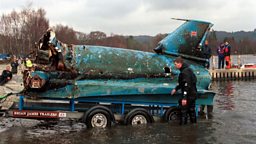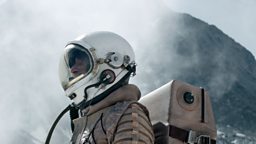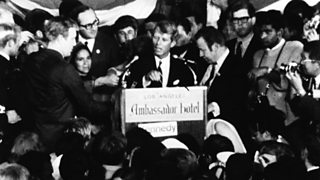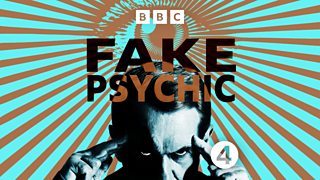Six eerie predictions from The Premonitions Bureau
Set up to collect visions of impending disasters, the establishment of a 'Premonitions Bureau' in 1967 marked one of the strangest episodes in the history of British psychological history. Across 18 months, its founder, Dr John Barker, collected hundreds of these reports.
This fascinating story, documented in a bestselling book by New York Times journalist and author Sam Knight, and now available to listen to as an eight-part boxset from BBC Radio 4, throws up a number of eerily accurate predictions.
Here are just some of the strangest ones associated with the Bureau.
1. The Aberfan disaster
The origin of the Bureau is the Aberfan disaster of October 1966, a tragic incident where a colliery tip slid down a mountainside to engulf a village school and a row of houses. A total of 144 people died, most of them children.
Mummy, last night I dreamt I went to school and there was no school there.Ten-year-old Eryl May Jones
Researching a book about whether it was possible to be scared to death, psychiatrist John Barker travelled to Aberfan to investigate a reported case. But his sense of the unorthodox and unexplained was diverted by hearing a number of portents about the disaster.
One chilling example was the story of Eryl May Jones. Described by a local minister as "a 10-year-old girl not given to imagination", on the day before the tragedy, Eryl apparently said to her mother: "Mummy, last night I dreamt I went to school and there was no school there. Something black had come down all over it."

2. Donald Campbell's portent of doom
Barker was motivated to collect more premonitions around Aberfan and asked an acquaintance of his, Peter Fairley, the science editor of the London Evening Standard, to help publicise an appeal. Among the 76 replies were contributions from post office worker Alan Hensher and music teacher Lorna Middleton, both of whom had a track record of vivid premonitions and would become pivotal to the Premonitions Bureau – the culmination of Barker’s desire to widen his research into precognition.
I have the most awful premonition. I'm going to get the chop this time.Donald Campbell
On the day that the Evening Standard carried news of the Bureau, Donald Campbell, the multiple world record holder for speeds on land and water, was attempting to set another water speed record. The previous evening Campbell had been up late playing Russian Patience. He dealt himself the ace of spades, followed by the Queen. As he told a friend, Mary Queen of Scots had drawn the same cards before her beheading in 1587. "I have the most awful premonition. I'm going to get the chop this time," Campbell told him, adding: "I've had the feeling for days."
The next day Campbell's speedboat Bluebird somersaulted off the surface of Coniston Water, plunging back into the lake. The accident killed Campbell, whose body was only recovered in 2001.
3. 1967 Nicosia Britannia disaster
While Donald Campbell's demise was coincidental to the Bureau, other events directly raised its profile.
On 21 March 1967, Alan Hensher called Barker to tell him about a vision he'd had about a plane crash. It involved a passenger aircraft getting into trouble over some mountains soon after take-off and radio contact being lost. He also predicted that 124 people would die.
A month later, a turboprop Britannia passenger aircraft carrying 130 people attempted to land in Nicosia, Cyprus during a thunderstorm. The first attempt to land failed. On the second attempt, the plane clipped one of its wings on the side of a hill, rolled over, broke into pieces and caught fire. The death toll for the disaster – the sixth worst aviation accident in history at the time – was 126.

4. The Soyuz 1 disaster
The following month it was Lorna Middleton's prescience that would startle followers of the Bureau's work.
Lorna Middleton enclosed a drawing of an astronaut crouched inside a crude spherical craft.
On 23 April 1967, Middleton sent in a vision of an astronaut on his way to the Moon. "This venture will end in tragedy," she wrote. The spaceman that she saw was petrified, and Middleton enclosed a drawing of an astronaut crouched inside a crude spherical craft.
At the same time that Middleton posted her message, cosmonaut Vladimir Mikhaylovich Komarov was on the Soyuz 1 spacecraft on his 12th orbit of Earth. He was to be joined by a second Soyuz spaceship in orbit the following day for two cosmonauts to transfer from one vehicle to the other and for both modules to return to Earth. Nothing like this had been attempted before, and few details had been released beforehand.
There was a great deal of concern about the mission before it launched, and things started to go wrong almost as soon as it did. The second Soyuz launch was abandoned, and Komarov was told to rest and prepare to return to Earth. On his first two attempts at re-entry, Komarov's engines failed to fire and the spacecraft bounced back into orbit. Komarov made it through on the third attempt but then the spacecraft's parachutes failed. The Soyuz fell until it hit open ground in southern Russia, not far from the Kazakh border. The wreckage caught fire, and Komarov was burned inside.
5. The Hither Green rail crash
The next significant premonition report to the Bureau was almost a team effort from Middleton and Hensher.
On 11 October 1967, Hensher contacted Barker with a warning of a mainline rail crash that would cause numerous fatalities. Then, on 1 November, Middleton wrote to Barker that she had been feeling acutely depressed and that she’d had a vision of a crash "maybe on a railway, a station, maybe involved people waiting in the station and the words Charing Cross".
Just over a month after Middleton's warning, an express service between Hastings and Charing Cross was between two suburban stations. One of the carriages hit a 5ins break in the tracks, jumped the rails and flipped four carriages onto their sides. People were thrown about like dolls. Two of the carriages had their sides ripped off, and windows were smashed all the way down the train.
At the time of the crash, Alan Hensher was on a shift at the GPO. He complained of a severe headache and was taken to the sickbay. At 10.15pm, he wrote a note saying that he thought there had been a railway accident and that it might have happened about an hour ago. The train had come off the rails at 9.16pm.
6. The assassination of Robert Kennedy
Many of the predictions Barker received were about events rather than personalities. Two major exceptions were Hensher's warnings to Barker of threats to his life and Middleton's very strong feeling that Robert Kennedy, brother of assassinated president John F Kennedy, would be killed.

Given what happened to his brother, and from the amount of threats Robert received on the campaign trail for the Democratic presidential nomination in 1968, perhaps the anticipation of this was unsurprising. However, the ferocity of Middleton's premonitions was notable.
On 11 March, she had written to Barker warning of an assassination. Four days later, she wrote again, "the word assassination continues. I cannot disconnect it from Robert Kennedy. It may be that history will repeat itself." Middleton repeated her warnings about Kennedy throughout April, and on 4 June, she called the Premonitions Bureau three times, warning that a killing was imminent.
Kennedy was shot in the head shortly after midnight (Pacific Daylight Time) on 6 June in LA.
John Barker died later the same year, and with him went the Premonitions Bureau.
You can listen to all eight episodes of The Premonitions Bureau on BBC Sounds here.
More from BBC Radio 4
-
![]()
The Expectation Effect by David Robson
The remarkable science of our mindset, and how your brain can change your world for the better.
-
![]()
Fake Psychic
Vicky Baker investigates the stranger-than-fiction story of Lamar Keene, who confessed to being part of the "psychic mafia".
-
![]()
So You've Been Publicly Shamed, by Jon Ronson
Jon Ronson's startling journey into the lives of people ruined by a badly worded tweet or a work faux pas.
-
![]()
Disaster Trolls
What happens when tragedy makes you a target? BBC disinformation and social media correspondent Marianna Spring investigates.





